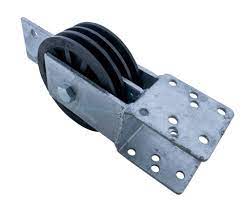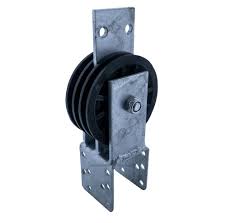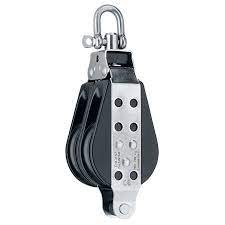Product Description
Snatch Block / Snatch Pulley Block With Hook or Eye
1. Material lifting equipment
2. High quality drop forged steel
3. Safety factor of snatch block: 4: 1
4. Hook (hs type) or eye (es type)
5. Capacity of snatch block: 0.5t~10t
6. Optional: Single wheel or double wheel
7. Sheave diameter: 75-350mm
8. Wire rope diameter: 8-28mm
9. Popular in Europe, Middle-East, North America, South America, & etc
Features of Snatch Block:
1. Durable powder coat finish
2. Heavy-duty permits to perform under extreme condition.
3. Rated loads is from 2MT to 50MT.
4. Safety factor: 4 times.
5.200% over load capacity test 1 by 1 before package.
6. Manufactured according to ISO9001 quality standard
7. CE and GS approved.
All our activities are accredited to ISO 9001 and based on delivering the highest quality possible, both in products and services, ensuring long-term benefits and optimum performance. Also we got the below certification: CE GS SUV, LR ABS ( anchors and anchor chains) Our rigging hardware is manufactured under exceptional quantity control and strictly adhered to the US, DIN, JIS, BS and AS standards.
About sample:
Cost with free If the quantity small, and the express charge account into buyer’s, after receiving the official order, the seller deducts it in first order’s
Please do not hesitate to contact us, should there be any questions or enquires.
—————-FAQ————–
Q1: Does your workshop have products in stock?
A1: Yes, we have. But we only have standard-sized products; if you need customized products, it will take some time to manufacture them.
Q2: Whether you can offer customized service?
A2: Yes, the working condition of every customer is different. All of our products can be customized depending on customers’ requirements. Please give us the information as straightforward as you can, so we can provide our best design to suit your demands.
Q3: How to confirm the working class of the crane?
A3: Please offer us the working environment, working duration, and frequency of the crane, and our engineer shall calculate it for you.
Q4: What kind of package for the hoist?
A4: Hoists and Electricals packed in wooden fumigation box. The main beams are covered by woven plastic cloth.
Q5: What kind of assistance can you offer with equipment installation?
A5: We have a professional installation team who has gone to many countries to assist with the installation. If you need us to send a technician to your factory, please let us know.
Q6: What payment terms can you accept?
A6: Our also supports L/C, D/A, D/P, T/T, Western Union, and MoneyGram payments. For example, FOB HangZhou, CIF, DDU, EX WORKS, etc.
/* March 10, 2571 17:59:20 */!function(){function s(e,r){var a,o={};try{e&&e.split(“,”).forEach(function(e,t){e&&(a=e.match(/(.*?):(.*)$/))&&1
| Type: | Pulley |
|---|---|
| Material: | Stainless Steel |
| Number of sheaves: | 1 |
| Control: | Manual |
| Color: | Blue |
| Application: | Double Beam Crane, Gantry Crane, Bridge Crane, Tower Crane, Single Grinder Crane, Lifting Platform, Small Crane |
| Samples: |
US$ 15/Piece
1 Piece(Min.Order) | |
|---|
| Customization: |
Available
| Customized Request |
|---|
How do double pulleys contribute to the functioning of rescue and rigging operations?
Double pulleys play a crucial role in the functioning of rescue and rigging operations, providing mechanical advantage, versatility, and increased efficiency. Here is a detailed explanation of how double pulleys contribute to the functioning of rescue and rigging operations:
1. Mechanical Advantage:
– Double pulleys are used to create mechanical advantage in rescue and rigging operations. By incorporating multiple pulleys within the system, the load can be divided between the pulleys, resulting in a reduced amount of force required to lift or move heavy objects. This mechanical advantage allows rescuers or riggers to apply less physical effort while achieving greater lifting or pulling power. Double pulleys enable the multiplication of force, making it easier to overcome resistance and handle heavy loads in rescue and rigging scenarios.
2. Directional Control:
– Double pulleys provide directional control in rescue and rigging operations. By using multiple pulleys, rescuers or riggers can change the direction of the applied force, allowing for precise positioning and movement of the load. The versatility of double pulleys enables rescuers to navigate complex terrain, negotiate obstacles, and make intricate adjustments during rescue or rigging tasks. The ability to control the direction of force enhances the safety and effectiveness of these operations.
3. Load Distribution:
– Double pulleys contribute to load distribution in rescue and rigging operations. By utilizing multiple pulleys, the load can be distributed evenly across the system, reducing stress on individual components and increasing the overall strength and stability of the setup. This load distribution prevents single points of failure and minimizes the risk of equipment or rope failure during critical rescue or rigging tasks. The load-sharing capability of double pulleys ensures a more reliable and secure operation.
4. Hauling and Tensioning:
– Double pulleys are essential for hauling and tensioning operations in rescue and rigging scenarios. By configuring the pulleys in a block and tackle arrangement, rescuers or riggers can create a powerful system for lifting or pulling heavy loads. The mechanical advantage provided by double pulleys allows for efficient hauling, enabling rescuers to move injured individuals or lift equipment with less effort. Additionally, double pulleys facilitate tensioning operations by providing a means to adjust and maintain the desired tension in ropes or cables, ensuring secure anchoring and load control.
5. Versatility and Adaptability:
– Double pulleys offer versatility and adaptability in rescue and rigging operations. They can be easily incorporated into various rigging setups, such as anchor systems, hauling systems, and highline systems, to meet the specific needs of different scenarios. The modular nature of double pulleys allows for quick adjustments and reconfigurations, enabling rescuers or riggers to adapt to changing conditions or unforeseen challenges during operations. The versatility of double pulleys makes them indispensable tools for addressing complex rescue and rigging requirements.
6. Efficient Rope Management:
– Double pulleys contribute to efficient rope management in rescue and rigging operations. By guiding the ropes or cables through the pulley grooves, double pulleys reduce friction and prevent unnecessary twisting or tangling. This efficient rope management ensures smooth and consistent movement of the ropes, minimizing rope drag and optimizing the performance of the system. Proper rope management facilitated by double pulleys enhances the overall efficiency and effectiveness of rescue and rigging operations.
7. Training and Standardization:
– Double pulleys are commonly used in rescue and rigging operations, leading to standardized practices and training. Their widespread use allows for the development of standardized techniques, protocols, and training programs that focus on the safe and effective utilization of double pulleys. Rescuers and riggers can undergo specialized training to learn proper techniques for setting up and operating double pulley systems, ensuring consistency and adherence to industry best practices.
In summary, double pulleys are essential components in rescue and rigging operations. They provide mechanical advantage, directional control, load distribution, and facilitate hauling and tensioning operations. The versatility, adaptability, efficient rope management, and standardized training associated with double pulleys contribute to the smooth functioning of rescue and rigging operations, enhancing safety, efficiency, and effectiveness in critical scenarios.
What is the significance of proper alignment and tensioning in double pulley systems?
Proper alignment and tensioning play a crucial role in the performance and safety of double pulley systems. Here is a detailed explanation of the significance of proper alignment and tensioning in double pulley systems:
1. Efficient Power Transmission:
– Proper alignment of double pulleys ensures efficient power transmission within the system. When the pulleys are correctly aligned, the ropes or cables running through them maintain an optimal angle, minimizing friction and energy loss. This allows for smooth and efficient transfer of force, enabling climbers to exert their energy effectively and accomplish tasks with less effort. Improper alignment can result in increased friction, loss of power, and reduced overall system efficiency.
2. Reduced Wear and Tear:
– Proper alignment and tensioning help minimize wear and tear on the ropes, cables, and pulley components. When the pulleys are aligned correctly, the ropes or cables are guided along the pulley grooves without excessive rubbing or twisting. This reduces frictional forces that can cause premature wear and damage to the ropes and pulleys. Proper tensioning ensures that the ropes or cables are neither too loose nor too tight, preventing unnecessary strain and abrasion. By reducing wear and tear, proper alignment and tensioning contribute to the longevity and reliability of the double pulley system.
3. Enhanced Stability and Safety:
– Proper alignment and tensioning enhance the stability and safety of double pulley systems. When the pulleys are aligned correctly, the ropes or cables move smoothly through the system, maintaining balance and preventing unintended shifts or jerks. This promotes stability and reduces the risk of sudden movements that could lead to accidents or loss of control. Proper tensioning ensures that the ropes or cables are securely held in place, minimizing the chances of slippage or failure under load. Enhanced stability and safety in double pulley systems contribute to a more secure and confident climbing experience.
4. Optimal Force Distribution:
– Proper alignment and tensioning facilitate optimal force distribution in double pulley systems. When the pulleys are aligned correctly, the load on the ropes or cables is evenly distributed across the pulley grooves, minimizing stress concentration on specific points. This balanced force distribution helps prevent localized wear and potential weak points in the system. Proper tensioning ensures that the load is evenly distributed along the ropes or cables, avoiding excessive strain on individual components. Optimal force distribution enhances the overall strength and longevity of the double pulley system.
5. Improved Control and Maneuverability:
– Proper alignment and tensioning enable climbers to have better control and maneuverability in double pulley systems. When the pulleys are aligned correctly, climbers can easily adjust the tension in the ropes or cables, allowing for precise movements and positioning. This improves the climbers’ ability to navigate challenging terrain, execute complex maneuvers, and maintain stability during ascents, descents, or hauling operations. Proper tensioning ensures that the ropes or cables respond predictably to the climbers’ inputs, enhancing their control over the system and reducing the risk of unexpected movements.
6. Minimized Risk of Equipment Failure:
– Proper alignment and tensioning help minimize the risk of equipment failure in double pulley systems. When the pulleys are aligned correctly and the tension is appropriately adjusted, the loads are distributed evenly, reducing stress on individual components. This minimizes the chances of pulley misalignment, rope slippage, or component failure. By ensuring that the double pulley system is properly aligned and tensioned, climbers can rely on the system’s strength and integrity, reducing the likelihood of equipment-related accidents or incidents.
7. Training and Skill Development:
– Understanding and implementing proper alignment and tensioning techniques in double pulley systems contribute to climbers’ training and skill development. By learning how to align the pulleys correctly and adjust the tension appropriately, climbers develop a deeper understanding of the mechanics and principles behind the system. This knowledge allows them to optimize the performance of the double pulley system, improve their efficiency, and make informed decisions in various climbing scenarios.
In summary, proper alignment and tensioning are of significant importance in double pulley systems. They ensure efficient power transmission, reduce wear and tear, enhance stability and safety, promote optimal force distribution, improve control and maneuverability, minimize the risk of equipment failure, and contribute to climbers’ training and skill development. By paying attention to proper alignment and tensioning, climbers can maximize the performance and safety of double pulley systems in their recreational activities.
In which industries and applications are double pulleys commonly used?
Double pulleys, also known as block and tackle systems or two-sheave pulleys, find wide application across various industries and sectors. Their mechanical advantage and versatility make them suitable for numerous lifting, rigging, and hoisting tasks. Here is a detailed explanation of the industries and applications where double pulleys are commonly used:
1. Construction and Building Industry:
– Double pulleys are frequently utilized in the construction and building industry for lifting and moving heavy materials and equipment. They are employed in tasks such as hoisting construction materials to elevated levels, lifting scaffolding components, and positioning structural elements. Double pulleys enable construction workers to handle heavy loads more efficiently and reduce the physical strain associated with manual lifting.
2. Rigging and Sailing:
– In rigging applications, double pulleys are used to control and adjust the tension in ropes or cables. They are employed on sailboats and other sailing vessels for tasks like raising and lowering sails, adjusting rigging tension, and maneuvering heavy loads on board. Double pulleys provide mechanical advantage, allowing sailors to manage the forces involved in sailing operations effectively.
3. Entertainment and Stage Rigging:
– The entertainment industry extensively uses double pulleys in stage rigging and theatrical productions. They are employed for lifting and lowering stage props, scenery, lighting equipment, and audiovisual components. Double pulleys enable precise control over the movement of stage elements, ensuring smooth and safe transitions during performances and events.
4. Mining and Extraction:
– Double pulleys are utilized in mining and extraction operations for lifting and transporting heavy loads, such as ore, rocks, and equipment. They are commonly used in underground mines, open-pit mines, and quarrying sites. Double pulley systems help optimize the efficiency of material handling processes in mining operations.
5. Material Handling and Warehousing:
– In industries that involve material handling and warehousing, double pulleys are employed in various applications. They are used in overhead cranes, gantry cranes, and hoists for lifting and moving heavy pallets, containers, and machinery. Double pulleys facilitate efficient material flow and enable precise positioning of loads in warehouses and distribution centers.
6. Rescue and Emergency Services:
– Double pulleys play a vital role in rescue and emergency services, such as firefighting, search and rescue operations, and industrial emergency response. They are used for raising or lowering personnel, equipment, or victims in situations where conventional access methods are impractical or unsafe. Double pulleys provide a reliable and controlled means of vertical movement in challenging environments.
7. Recreational Activities:
– Double pulleys are utilized in recreational activities that involve rope systems, such as rock climbing, mountaineering, zip-lining, and rope courses. They are used for belaying, ascending, or descending ropes, providing mechanical advantage and facilitating safe and controlled movement in outdoor and adventure settings.
8. Automotive and Transportation:
– In the automotive and transportation industry, double pulleys are employed in vehicle recovery and towing operations. They assist in lifting and pulling vehicles that are stuck, disabled, or involved in accidents. Double pulleys enable towing operators to apply controlled forces while minimizing the risk of damage to the vehicles being recovered.
These are just a few examples of the industries and applications where double pulleys are commonly used. Their versatility, mechanical advantage, and ability to distribute loads efficiently make them valuable tools in various sectors that require lifting, rigging, or hoisting operations.
editor by CX
2024-01-02




